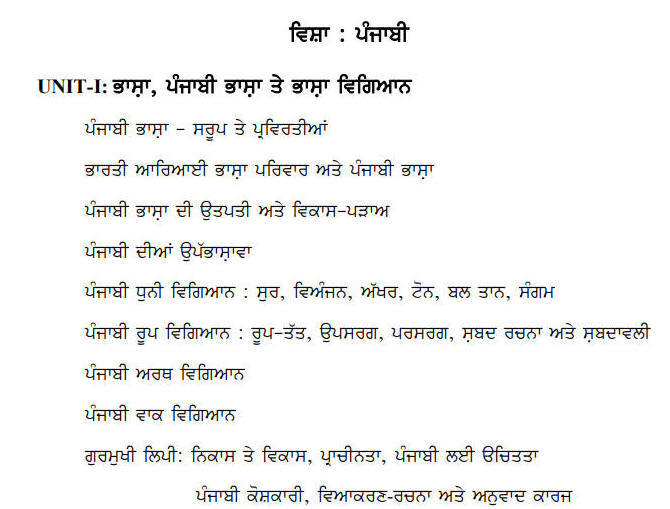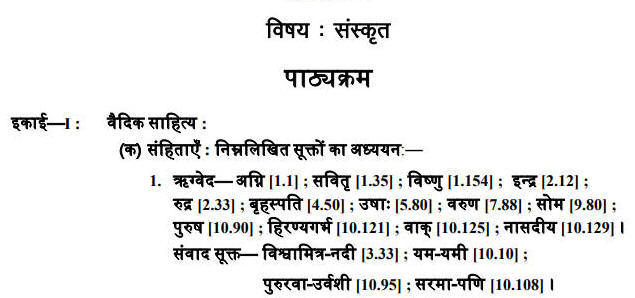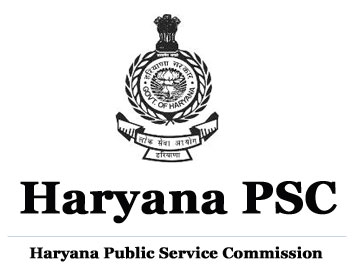(Syllabus) Haryana PSC: Assistant Professor
(Syllabus) Haryana PSC: Assistant Professor
Physical Chemistry:
1. Basic principles and applications of quantum mechanics – hydrogen atom,
angular momentum.
2. Variational and perturbational methods.
3. Basics of atomic structure, electronic configuration, shapes of orbitals,
hydrogen atom spectra.
4. Theoretical treatment of atomic structures and chemical bonding.
5. Chemical applications of group theory.
6. Basic principles and application of spectroscopy – rotational, vibrational,
electronic, Raman, ESR, NMR.
7. Chemical thermodynamics.
8. Phase equilibria.
9. Statistical thermodynamics.
10. Chemical equilibria.
11. Electrochemistry – Nernst equation, electrode kinetics, electrical double
layer, Debye-Hückel theory.
12. Chemical kinetics – empirical rate laws, Arrhenius equation, theories of
reaction rates, determination of reaction mechanisms, experimental techniques
for fast reactions.
13. Concepts of catalysis.
14. Polymer chemistry. Molecular weights and their determinations. Kinetics of
chain polymerization.
15. Solids - structural classification of binary and ternary compounds,
diffraction techniques, bonding, thermal, electrical and magnetic properties
16. Colloids and surface phenomena.
17. Data analysis.
<<Read more>>
Commerce:
Unit – I : Business Environment :
Meaning and Elements of Business Environment.
Economic environment, Economic Policies, Economic Planning.
Legal environment of Business in India: Competition policy, Consumer protection,
Environment protection.
Policy Environment : Liberalization Privatisation and globalisation, Second
generation reforms, Industrial policy and implementation. Industrial growth and
structural changes.
<<Read more>>
Computer:
UNIT - I
Representation of Numbers : Octal, Hexadecimal, Decimal and Binary. 2′s complement and 1′s complement arithmetic. Floating-point representation of numbers.
Logic Families : Boolean algebra and Minimization of Boolean functions. Predicate Logic, Well-formed-formulae (WFF), Satisfiability and Tautology.
Sequential Circuits: Flip-flops – types, race condition and comparison, registers, counters.
Combinational Circuits: adders, subtractors, multiplexer, demultiplexers, encoder, decoder, code converters.
CPU Organization: types, control unit – hardwired and micro-programmed, instruction formats, addressing modes, CPU registers, instruction cycle.
Memory Organization: Memory types and organizations, interfacing peripheral devices, interrupts.
<<Read more>>
Economics:
1. Micro – Economic Analysis
Demand Analysis – Marshallian, Hicksian and Revealed preference approaches
Consumer behaviour under conditions of uncertainty.
Theory of Production and Costs.
Pricing and output under different forms of market structure.
Different models of objectives of the firm – Baumol, Morris and Williamson.
Factor Pricing analysis.
Elements of general equilibrium and new welfare economics.
<<Read more>>
English:
1. British Literature from Chaucer to the present day
2. Criticism and Literary Theory.
3. Literary Comprehension
Unit – I : Up to the Renaissance.
Unit – II : Jacobean to Restoration Periods.
Unit – III : Augustan Age 18th Century Literature.
Unit – IV : Romantic Period.
Unit – V : Victorian and Pre – Raphaelites.
Unit – VI : Modem British Literature.
Unit – VII : Contemporary British Literature.
Unit – VIII : Literary Theory and Criticism up to T. S. Eliot.
Unit – IX : Contemporary Theory
<<Read more>>
Geography:
Unit – I
Geomorphology : Fundamental concepts ; Factors controlling’landform
development; Endogenetic and Exdgenetic forces; Denudation process: weathering.
and erosion, Geosynclines, mountain building, continental drift and plate
tectonics; Concept of Geomorphic Cycle; Landforms associated with fluvial,
glacial, arid, coastal and karst cycles, Slope forms and processes;
Environmental and Applied Geomorphology.
<<Read more>>
History:
1. CONCEPTS, IDEAS AND TERMS
| Bharatvarsha | Kara/Vishti |
| Sabha and Samiti | Stridhana |
| Varnasrama | Memorial stones |
| Purusharthas | Agraharas |
| Rina | Khilafat |
| Samskaras | Sulah-i-Kul |
| Yojna | Maharashtra-dharma |
| Doctrine of Karma | Turkan-i-Chahlghani |
| Dandaniti/Arthasastra | Watan |
| Saptanga | Baluta |
<<Read more>>
Mathematics:
UNIT – 1
Analysis: Elementary set theory, finite, countable and uncountable sets,
Real number system as a
complete ordered field, Archimedean property, supremum, infimum.
Sequences and series, convergence, limsup, liminf.
Bolzano Weierstrass theorem, Heine Borel theorem.
Continuity, uniform continuity, differentiability, mean value theorem.
Sequences and series of functions, uniform convergence.
Riemann sums and Riemann integral, Improper Integrals.
Monotonic functions, types of discontinuity, functions of bounded variation.
Lebesgue measure, Lebesgue integral.
Functions of several variables, directional derivative, partial derivative,
derivative as a linear
transformation, Inverse and Implicit Function theorems.
Metric spaces, compactness, connectedness. Normed linear Spaces. Spaces of
continuous
functions as examples.
<<Read more>>
Physical Education:
Unit – I
-
Definition, aim and objectives of Physical Education, Health education and Recreation.
-
Philosophies of Education as applied to Physical Education – Idealism, Naturalism, Realism, Pragmatism, Existentialism and Humanism.
-
Biological basis of physical activity – benefits of exercise, growth and exercise, exercise. and well – being sex and age characteristics of adolescent, body types.
-
Psychological basis of Physical Education – Play and Play theories, general principles of growth and development, Principles of motor – skill acquisition, transfer of training effects.
-
Sociological basis of Physical Education – socialization process, social nature of men and physical activity, sports as cultural heritage of mankind, customs, traditions and sport competition and cooperation.
-
Physical Education in ancient Greece, Rome and Contemporary Germany, Sweden, Denmark and Russia.
-
Olympic Movement – Historical development of Ancient and Modern Olympic Games.
-
Physical Education in India.
<<Read more>>
Political Science:
1. Political Theory and Thought
Ancient Indian Political Thought : Kautilya and Shanti Parva.
Greek Political Thought : Plato and Aristotle.
European Thought – I : Machiavelli, Hobbes, Locke, Rousseau.
European Thought – II : Bentham, J. S. Mill, Hegel, Marx and Green.
Contemporary Political Thought – I : Lenin, Mao, Gramsci.
Contemporary Political Thought – II : Rawls, Nozic and Communitarians.
Modern Indian Thought : Gandhi, M. N. Roy, Aurobindo Ghosh, Joy Prakash
Ambedkar, Savarkar.
Concepts and Issue – I : Medieval Political Thought: Church State
Relationship and Theory of Two Swords.
Concepts and Issue – II : Behaviouralism and Post-Behaviouralism, Decline
and Resurgence of Political Theory. Democracy, Liberty and Equality.
<<Read more>>
Psychology:
1. Perceptual Processes
Approaches to the Study of Perception : Gestalt and physiological approaches.
Perceptual Organization : Gestalt, Figure and Ground, Laws of Organization.
Perceptual Constancy : Size, Shape and Brightness, Illusion; Perception of Depth
and Movements.
Role of motivation and learning in perception.
Signal detection theory, subliminal perception and related factors, information processing approach to perception, culture and perception, perceptual styles. Ecological perspective on perception
<<Read more>>
Public Administration:
1. Theory of UGC NET Public Administration
- Public Administration – Meaning, Nature and Scope, Public and Private Administration, New Public Administration, New Public Management.
- Administrative Thinkers – Kautilya, Wood row Wilson, Max Weber, F. W. Taylor, Henri Fayol, M. P. Follet, Elton Mayo, C.I. Barnard, Herbert Simon, D. H. McGregor, Abraham Maslow, Herzberg, Chris Argyris and F.W. Riggs Luther Guclick and L. Urwick.
- Theories – Classical, Human Relations, Bureaucratic, Public Choice.
- Approaches to the study of Public Administration – Scientific Management, Behavioural Systems, Structural – Functional, Decision-making, Public Policy and Marxian.
- Organisation – Bases of Organisation, Formal and Informal, Principles of Organisation – Hierarchy, Span of Control, Unity of Command, Delegation, Decentralisation and Coordination; Line – Staff Agencies.
- Leadership, Motivation and Communication.
<<Read more>>
Sociology:
Note: - There are Four Parts of the Syllabus i.e.
A: Sociological Concepts,
B: Sociological Theory,
C: Methodology and
D: Theoretical Perspectives and emerging trends in sociology
A: Sociological Concepts
1. Nature of Sociology
Definition
Sociological Perspective
2. Basic Concepts
Community
Institution
Association
Culture
Norms and Values.
3. Social Structure
Status and role, their interrelationship.
Multiple roles, Role set. Status set, Status sequence.
Role conflict.
<<Read more>>
Zoology:
1. MOLECULES AND THEIR INTERACTION RELEVANT TO BIOLOGY
A. Structure of atoms, molecules and chemical bonds.
B. Composition, structure and function of biomolecules (carbohydrates,
lipids, proteins, nucleic acids and vitamins).
C. Stablizing interactions (Van der Waals, electrostatic, hydrogen
bonding, hydrophobic interaction, etc.).
D. Principles of biophysical chemistry (pH, buffer, reaction kinetics,
thermodynamics, colligative properties).
E. Bioenergetics, glycolysis, oxidative phosphorylation, coupled
reaction, group transfer, biological energy transducers.
F. Principles of catalysis, enzymes and enzyme kinetics, enzyme
regulation, mechanism of enzyme catalysis, isozymes.
G. Conformation of proteins (Ramachandran plot, secondary, tertiary and
quaternary structure; domains; motif and folds).
H. Conformation of nucleic acids (A-, B-, Z-,DNA), t-RNA, micro-RNA).
I. Stability of protein and nucleic acid structures.
J. Metabolism of carbohydrates, lipids, amino acids, nucleotides and
vitamins.
<<Read more>>
Hindi:
1. हिन्दी भाषा और उसका विकास
अप्रंश (अवहट्ट सहित) और पुरानी हिन्दी का सम्बन्ध, काव्य भाषा के रुप में अवधी का उदय और विकास, काव्यभाषा के रूप में ब्रज़भाषा का उदय और विकास, साहित्यिक हिन्दी के रूप में खड़ी बोली का उदय और विकास, मानक हिन्दी का भाषा वैज्ञानिक विकरण (रूपगत) हिन्दी की बोलियाँ- वर्गीकरण तथा क्षेत्र, नागरी लिपि का विकास और उसका मानकीकरण| हिन्दी भाषा-प्रयोग के विविध रूप- बोली, मानकभाषा, सम्पर्कभाषा, राजभाषा और राष्ट्रभाषा, संचार माध्यम और हिन्दी।
<<Read more>>
Punjabi:

<<Read more>>
Sanskrit:

<<Read more>>
Courtesy: HPSC



